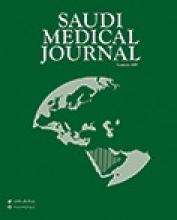Abstract
OBJECTIVE: The aim of this retrospective study is to delineate the histopathological profile of colorectal cancers seen at King AbdulAziz University Hospital, Jeddah, Kingdom of Saudi Arabia and to compare our findings with 12 other studies published in the literature from other areas of the Kingdom of Saudi Arabia.
METHODS: Our study group consisted of 39 colorectal cancer patients, who were examined in the department of Histopathology at King AbdulAziz University Hospital, Jeddah, Kingdom of Saudi Arabia, over a period of 4 years from January 1996 to December 2000. The data was retrieved and analyzed. The histopathological characteristics of the tumor such as tumor differentiation, tumor Duke's staging and grade of all the tumors were studied and compared with age of the patients.
RESULTS: We received 2552 gastrointestinal endoscopic specimens during a 4 year period; out of these 276 were colorectal specimens. We found 39 cases (21 males and 17 females) of colorectal cancer during this period, which constituted 1.5% of total endoscopic biopsies and 13.8% of colorectal biopsies. Among these cases there were 31 cases (81%, mean age 56) of colorectal adenocarcinoma, 3 cases (7.6%, mean age 35) of signet cell carcinoma, 2 cases (5%, mean age 55.5) of mucinous adenocarcinoma, one case (2.5%, age 68) of metastatic papillary carcinoma, one case of mixed mucin secreting signet cell carcinoma (2.5%, age 64) and one case (2.5%, age 55) of poorly differentiated squamous cell carcinoma. In our study 21% of patients presented in their 3rd decade of life, 18.4% in the 4th decade, 15.8% in the 5th decade, 26.3% in the 6th decade, 10.5% in the 7th decade and 7.9% in the 8th decade.
CONCLUSION: Colorectal carcinoma showed frequent presentation in our population. Some malignant lesions showed early presentation as compared to United States of America, with 6.9% cases presenting at a young age and 23.6% of cases presented at middle age. In order to achieve early diagnosis, a comprehensive cancer education program should be planned and executed, and proper screening programs should be launched.
- Copyright: © Saudi Medical Journal
This is an open-access article distributed under the terms of the Creative Commons Attribution-Noncommercial-Share Alike 3.0 Unported, which permits unrestricted use, distribution, and reproduction in any medium, provided the original work is properly cited.






